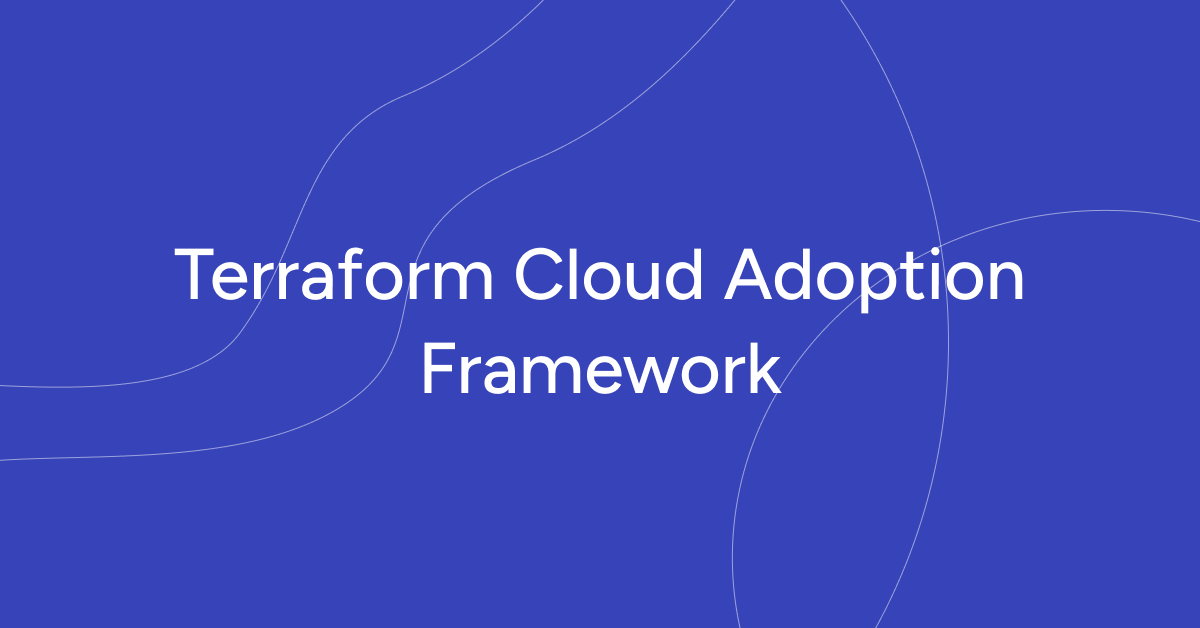
Cloud adoption is a crucial consideration for many enterprises. With the need to migrate from on-premises infrastructure to the cloud, businesses seek effective frameworks to streamline this transition. One such framework gaining traction is the Terraform Framework.
[lwptoc]
This article delves into the details of the Terraform Framework and its significance, particularly for enterprise-level cloud adoption projects. We will explore the background behind its adoption, the Cloud Adoption Framework for Microsoft, the concept of landing zones, and the four levels of the Terraform Framework.
https://youtu.be/vzCO-h4a9h4
Background and Adoption Strategy
Many large enterprises face the challenge of migrating their infrastructure from on-premises environments to the cloud. In response to this, Microsoft developed the Cloud Adoption Framework (CAF) as a strategic guide for customers to plan, adopt, and implement cloud services effectively.
Let's dive deeper into the components and benefits of the Terraform Framework within the Cloud Adoption Framework.
Understanding the Azure Cloud Adoption Framework (CAF)
The Cloud Adoption Framework for Microsoft (CAF) is a comprehensive framework that assists customers in defining their cloud strategy, planning the adoption process, and continuously implementing and managing cloud services. It covers various aspects of cloud adoption, from migration strategies to application and service management in the cloud. To gain a better understanding of this framework, it is essential to explore its core components.
Landing Zones
A fundamental component of the CAF is the concept of landing zones. A landing zone represents a scaled and secure Azure environment, typically designed for multiple subscriptions. It acts as the building block for the overall infrastructure landscape, ensuring proper connectivity and security between different application components and even on-premises systems. Landing zones consist of several elements, including security measures, governance policies, management and monitoring services, and application-specific services within a subscription.
CAF and Infrastructure Organization
The Microsoft documentation on CAF outlines different approaches to cloud adoption based on the size and complexity of an organization. Small organizations utilizing a single subscription in Azure will have a different adoption approach compared to large enterprises with numerous services and subscriptions. For enterprise-level deployments, an organized infrastructure landscape is crucial. This includes creating management groups and subscription organization, each serving specific governance and security requirements. Additionally, specialized subscriptions, such as identity subscriptions, management subscriptions, and connectivity subscriptions, are part of the overall landing zone architecture.
? Discover the power of Caf-Terraform, a revolutionary framework that takes your infrastructure management to the next level. Let's dive in!
The Four Levels of the Terraform Framework
The Terraform Framework, an open-source project developed by Microsoft architects and engineers, simplifies the deployment of landing zones within Azure. It consists of four main components: rover, models, landing zones, and launchpad.
a. Rover:
The rover is a Docker container that encapsulates all the necessary tools for infrastructure deployment. It includes Terraform itself and additional scripts, facilitating a seamless transition to CI/CD pipelines across different platforms. By utilizing the rover, teams can standardize deployments and avoid compatibility issues caused by different Terraform versions on individual machines.
b. Models:
The models represent cloud adoption framework templates, hosted within the Terraform registry or GitHub repositories. These templates cover a wide range of Azure resources, providing a standardized approach for deploying infrastructure components. Although they may not cover every single resource available in Azure, they offer a strong foundation for most common resources and are continuously updated and supported by the community.
c. Landing Zones:
Landing zones represent compositions of multiple resources, services, or blueprints within the context of the Terraform Framework. They enable the creation of complex environments by dividing them into manageable subparts or services. By modularizing landing zones, organizations can efficiently deploy and manage infrastructure based on their specific requirements. The Terraform state file generated from the landing zone provides valuable information for subsequent deployments and configurations.
d. Launchpad:
The launchpad serves as the starting point for the Terraform Framework. It comprises scripts and Terraform configurations responsible for creating the foundational components required for all other levels. By deploying the launchpad, organizations establish storage accounts, keywords, and permissions necessary for storing and managing Terraform state files for higher-level deployments.
Understanding the Communication between Levels
To ensure efficient management and organization, the Terraform Framework promotes a layered approach, divided into four levels:
Level Zero: This level represents the launchpad and focuses on establishing the foundational infrastructure required for subsequent levels. It involves creating storage accounts, setting up subscriptions, and permissions for managing state files.
Level One: Level one primarily deals with security and compliance aspects. It encompasses policies, access control, and governance implementation across subscriptions. The level one pipeline reads outputs from level zero but has read-only access to the state files.
Level Two: Level two revolves around network infrastructure and shared services. It includes creating hub networks, configuring DNS, implementing firewalls, and enabling shared services such as monitoring and backup solutions. Level two interacts with level one and level zero, retrieving information from their state files.
Level Three and Beyond: From level three onwards, the focus shifts to application-specific deployments. Development teams responsible for application infrastructure, such as Kubernetes clusters, virtual machines, or databases, engage with levels three and beyond. These levels have access to state files from the previous levels, enabling seamless integration and deployment of application-specific resources.
Simplifying Infrastructure Deployments
In order to create new virtual machines for specific applications, we can leverage the power of Terraform and modify the configuration inside the Terraform code. By doing so, we can trigger a pipeline that resembles regular Terraform work. This approach allows us to have more control over the deployment and configuration of virtual machines.
Streamlining Service Composition and Environment Delivery
When discussing service composition and delivering a complete environment, this layered approach in Terraform can be quite beneficial. We can utilize landing zones or blueprint models at different levels. These models have input variables and produce output variables that are saved into the Terraform state file. Another landing zone or level can access these output variables, use them within its own logic, compose them with input variables, and produce its own output variables.
Organizing Teams and Repositories
This layered approach, facilitated by Terraform, helps to organize the relationship between different repositories or teams within an organization. Developers or DevOps professionals responsible for creating landing zones or cleaning zones can work locally with the Rover container in VS Code. They write Terraform code, compose and utilize modules, and create landing zone logic.
Separation of Logic and Configuration
The logic and configuration in the Terraform code are split into separate files, similar to regular Terraform practices. The logic is stored in .tf and .tfvars files, while the configuration is stored in .tfvars files, which can be organized into different environments. This separation allows for better management and maintainability.
Empowering Application Teams
Within an organization, different teams can be responsible for different aspects of the infrastructure. An experienced Azure team can define the organization's standards and write the landing zone logic using Terraform. They can provide examples of configuration files that application teams can use. By offloading the configuration files to the application teams, they can easily create infrastructure for their applications without directly involving the operations team.
Standardization and Unification
This approach allows for the standardization and unification of infrastructure within the organization. With the use of modules in Terraform, teams don't have to start from scratch but can reuse existing code and configurations, creating a consistent and streamlined infrastructure landscape.
Challenges and Considerations
Working with Terraform and the Caf-terraform framework may have some complexities. For example, the Rover tool is not able to work with managed identities, requiring the management of service principals in addition to containers and managed identities. Additionally, there may be some bugs in the modules that need to be addressed, but the open-source nature of the framework allows for contributions and improvements. Understanding the framework and its intricacies may take some time due to the documentation being spread across multiple reports and components.
Key components and features of CAF Terraform:
ComponentDescriptionCloud Adoption Framework (CAF)Microsoft's framework that provides guidance and best practices for organizations adopting Azure cloud services.TerraformOpen-source infrastructure-as-code tool used for provisioning and managing cloud resources.Azure Landing ZonesPre-configured environments in Azure that provide a foundation for deploying workloads securely and consistently.Infrastructure as Code (IaC)Approach to defining and managing infrastructure resources using declarative code.Standardized DeploymentsEnsures consistent configurations and deployments across environments, reducing inconsistencies and human errors.ModularityOffers a modular architecture allowing customization and extension of the framework based on organizational requirements.CustomizabilityEnables organizations to adapt and tailor CAF Terraform to their specific needs, incorporating existing processes, policies, and compliance standards.Security and GovernanceEmbeds security controls, network configurations, identity management, and compliance requirements into infrastructure code to enforce best practices and ensure secure deployments.Ongoing ManagementSimplifies ongoing management, updates, and scaling of Azure landing zones, enabling organizations to easily make changes to configurations and manage the lifecycle of resources.Collaboration and AgilityFacilitates collaboration among teams through infrastructure-as-code practices, promoting agility, version control, and rapid deployments.Documentation and CommunityComprehensive documentation and resources provided by Microsoft Azure, along with a vibrant community offering tutorials, examples, and support for leveraging CAF Terraform effectively.This table provides an overview of the key components and features of CAF Terraform
Conclusion: Azure Cloud Adoption Framework
The Terraform Framework within the Cloud Adoption Framework (CAF) offers enterprises a powerful toolset for cloud adoption and migration projects. By leveraging the modular structure of landing zones and adhering to the layered approach, organizations can effectively manage infrastructure deployments in Azure. The Terraform Framework's components, including rover, models, landing zones, and launchpad, contribute to standardization, automation, and collaboration, leading to successful cloud adoption and improved operational efficiency.
As organizations embrace the cloud, the Caf-terraform framework provides a layered approach to managing infrastructure and deployments. By separating logic and configuration and leveraging modules, it allows for standardized and unified infrastructure across teams and repositories. This framework simplifies and optimizes the transition from on-premises to the cloud, enabling enterprises to harness the full potential of Azure's capabilities.
Empower your team with DevOps excellence! Streamline workflows, boost productivity, and fortify security. Let's shape the future of your software development together – inquire about our DevOps Consulting Services.

In this blog post, we will delve into the intricacies of on-premise to cloud migration, demystifying the process and providing you with a comprehensive guide. Whether you're a business owner, an IT professional, or simply curious about cloud migration, this post will equip you with the knowledge and tools to navigate the migration journey successfully.
How Cloud Migration Affects Your Business?
The impact of cloud migration on your company refers to the process of shifting operations from on-premise installations to the cloud. This migration involves transferring data, programs, and IT processes from an on-premise data center to a cloud-based infrastructure.
Similar to a physical relocation, cloud migration offers benefits such as cost savings and enhanced flexibility, surpassing those typically experienced when moving from a smaller to a larger office. The advantages of cloud migration can have a significant positive impact on businesses.
Pros and cons of on-premise to cloud migration
ProsConsScalabilityConnectivity dependencyCost savingsMigration complexityAgility and flexibilityVendor lock-inEnhanced securityPotential learning curveImproved collaborationDependency on cloud provider's reliabilityDisaster recovery and backupCompliance and regulatory concernsHigh availability and redundancyData transfer and latencyInnovation and latest technologiesOngoing operational costsTable summarizing the key aspects of on-premise to cloud migration
Looking for On-Premise to Cloud Migration? Contact Gart Today!
Gart's Successful On-Premise to Cloud Migration Projects
Optimizing Costs and Operations for Cloud-Based SaaS E-Commerce Platform
In this case study, you can find the journey of a cloud-based SaaS e-commerce platform that sought to optimize costs and operations through an on-premise to cloud migration. With a focus on improving efficiency, user experience, and time-to-market acceleration, the client collaborated with Gart to migrate their legacy platform to the cloud.
By leveraging the expertise of Gart's team, the client achieved cost optimization, enhanced flexibility, and expanded product offerings through third-party integrations. The case study highlights the successful transformation, showcasing the benefits of on-premise to cloud migration in the context of a SaaS e-commerce platform.
Read more: Optimizing Costs and Operations for Cloud-Based SaaS E-Commerce Platform
Implementation of Nomad Cluster for Massively Parallel Computing
This case study highlights the journey of a software development company, specializing in Earth model construction using a waveform inversion algorithm. The company, known as S-Cube, faced the challenge of optimizing their infrastructure and improving scalability for their product, which analyzes large amounts of data in the energy industry.
This case study showcases the transformative power of on-premise to AWS cloud migration and the benefits of adopting modern cloud development techniques for improved infrastructure management and scalability in the software development industry.
Through rigorous testing and validation, the team demonstrated the system's ability to handle large workloads and scale up to thousands of instances. The collaboration between S-Cube and Gart resulted in a new infrastructure setup that brings infrastructure management to the next level, meeting the client's goals and validating the proof of concept.
Read more: Implementation of Nomad Cluster for Massively Parallel Computing
Understanding On-Premise Infrastructure
On-premise infrastructure refers to the physical hardware, software, and networking components that are owned, operated, and maintained within an organization's premises or data centers. It involves deploying and managing servers, storage systems, networking devices, and other IT resources directly on-site.
Pros:
Control: Organizations have complete control over their infrastructure, allowing for customization, security configurations, and compliance adherence.
Data security: By keeping data within their premises, organizations can implement security measures aligned with their specific requirements and have greater visibility and control over data protection.
Compliance adherence: On-premise infrastructure offers a level of control that facilitates compliance with regulatory standards and industry-specific requirements.
Predictable costs: With on-premise infrastructure, organizations have more control over their budgeting and can accurately forecast ongoing costs.
Cons:
Upfront costs: Setting up an on-premise infrastructure requires significant upfront investment in hardware, software licenses, and infrastructure setup.
Scalability limitations: Scaling on-premise infrastructure requires additional investments in hardware and infrastructure, making it challenging to quickly adapt to changing business needs and demands.
Maintenance and updates: Organizations are responsible for maintaining and updating their infrastructure, which requires dedicated IT staff, time, and resources.
Limited flexibility: On-premise infrastructure can be less flexible compared to cloud solutions, as it may be challenging to quickly deploy new services or adapt to fluctuating resource demands.
Exploring the Cloud
Cloud computing refers to the delivery of computing resources, such as servers, storage, databases, software, and applications, over the internet. Instead of owning and managing physical infrastructure, organizations can access and utilize these resources on-demand from cloud service providers.
Benefits of cloud computing include:
Cloud services allow organizations to easily scale their resources up or down based on demand, providing flexibility and cost-efficiency.
With cloud computing, organizations can avoid upfront infrastructure costs and pay only for the resources they use, reducing capital expenditures.
Cloud services enable users to access their applications and data from anywhere with an internet connection, promoting remote work and collaboration.
Cloud providers typically offer robust infrastructure with high availability and redundancy, ensuring minimal downtime and improved reliability.
Cloud providers implement advanced security measures, such as encryption, access controls, and regular data backups, to protect customer data.
Cloud Deployment Models: Public, Private, Hybrid
When considering a cloud migration strategy, it's essential to understand the various deployment models available. Cloud deployment models determine how cloud resources are deployed and who has access to them. Understanding these deployment models will help organizations make informed decisions when determining the most suitable approach for their specific needs and requirements.
Deployment ModelDescriptionBenefitsConsiderationsPublic CloudCloud services provided by third-party vendors over the internet, shared among multiple organizations.- Cost efficiency - Scalability - Reduced maintenance- Limited control over infrastructure - Data security concerns - Compliance considerationsPrivate CloudCloud infrastructure dedicated to a single organization, either hosted on-premise or by a third-party provider.- Enhanced control and customization - Increased security - Compliance adherence- Higher upfront costs - Requires dedicated IT resources for maintenance - Limited scalability compared to public cloudHybrid CloudCombination of public and private cloud environments, allowing organizations to leverage benefits from both models.- Flexibility to distribute workloads - Scalability options - Customization and control- Complexity in managing both environments - Potential integration challenges- Data and application placement decisionsTable summarizing the key characteristics of the three cloud deployment models
Cloud Service Models (IaaS, PaaS, SaaS)
Cloud computing offers a range of service models, each designed to meet different needs and requirements. These service models, known as Infrastructure as a Service (IaaS), Platform as a Service (PaaS), and Software as a Service (SaaS), provide varying levels of control and flexibility for organizations adopting cloud technology.
Infrastructure as a Service (IaaS)
IaaS provides virtualized computing resources, such as virtual machines, storage, and networking infrastructure. Organizations have control over the operating systems, applications, and middleware while the cloud provider manages the underlying infrastructure.
Platform as a Service (PaaS)
PaaS offers a platform and development environment for building, testing, and deploying applications. It abstracts the underlying infrastructure, allowing developers to focus on coding and application logic rather than managing servers and infrastructure.
Software as a Service (SaaS)
SaaS delivers fully functional applications over the internet, eliminating the need for organizations to install, maintain, and update software locally. Users can access and use applications through a web browser.
Key Cloud Providers and Their Offerings
Selecting the right cloud provider is a critical step in ensuring a successful migration to the cloud. With numerous options available, organizations must carefully assess their requirements and evaluate cloud providers based on key factors such as offerings, performance, pricing, vendor lock-in risks, and scalability options.
Amazon Web Services (AWS): Offers a wide range of cloud services, including compute, storage, database, AI, and analytics, through its AWS platform.
Microsoft Azure: Provides a comprehensive set of cloud services, including virtual machines, databases, AI tools, and developer services, on its Azure platform.
Google Cloud Platform (GCP): Offers cloud services for computing, storage, machine learning, and data analytics, along with a suite of developer tools and APIs.
Read more: How to Choose Cloud Provider: AWS vs Azure vs Google Cloud
Checklist for Preparing for Cloud Migration
Assess your current infrastructure, applications, and data to understand their dependencies and compatibility with the cloud environment.
Identify specific business requirements, scalability needs, and security considerations to align them with the cloud migration goals.
Anticipate potential migration challenges and risks, such as data transfer limitations, application compatibility issues, and training needs for IT staff.
Develop a well-defined migration strategy and timeline, outlining the step-by-step process of transitioning from on-premise to the cloud.
Consider factors like the sequence of migrating applications, data, and services, and determine any necessary dependencies.
Establish a realistic budget that covers costs associated with data transfer, infrastructure setup, training, and ongoing cloud services.
Allocate resources effectively, including IT staff, external consultants, and cloud service providers, to ensure a seamless migration.
Evaluate and select the most suitable cloud provider based on your specific needs, considering factors like offerings, performance, and compatibility.
Compare pricing models, service level agreements (SLAs), and security measures of different cloud providers to make an informed decision.
Examine vendor lock-in risks and consider strategies to mitigate them, such as using standards-based approaches and compatibility with multi-cloud or hybrid cloud architectures.
Consider scalability options provided by cloud providers to accommodate current and future growth requirements.
Ensure proper backup and disaster recovery plans are in place to protect data during the migration process.
Communicate and involve stakeholders, including employees, customers, and partners, to ensure a smooth transition and minimize disruptions.
Test and validate the migration plan before executing it to identify any potential issues or gaps.
Develop a comprehensive training plan to ensure the IT staff is equipped with the necessary skills to manage and operate the cloud environment effectively.
Ready to unlock the benefits of On-Premise to Cloud Migration? Contact Gart today for expert guidance and seamless transition to the cloud. Maximize scalability, optimize costs, and elevate your business operations.
Cloud Migration Strategies
When planning a cloud migration, organizations have several strategies to choose from based on their specific needs and requirements. Each strategy offers unique benefits and considerations.
Lift-and-Shift Migration
The lift-and-shift strategy involves migrating applications and workloads from on-premise infrastructure to the cloud without significant modifications. This approach focuses on rapid migration, minimizing changes to the application architecture. It offers a quick transition to the cloud but may not fully leverage cloud-native capabilities.
Replatforming
Replatforming, also known as lift-and-improve, involves migrating applications to the cloud while making minimal modifications to optimize them for the target cloud environment. This strategy aims to take advantage of cloud-native services and capabilities to improve scalability, performance, and efficiency. It strikes a balance between speed and optimization.
Refactoring (Cloud-Native)
Refactoring, or rearchitecting, entails redesigning applications to fully leverage cloud-native capabilities and services. This approach involves modifying the application's architecture and code to be more scalable, resilient, and cost-effective in the cloud. Refactoring provides the highest level of optimization but requires significant time and resources.
Hybrid Cloud
A hybrid cloud strategy combines on-premise infrastructure with public and/or private cloud resources. Organizations retain some applications and data on-premise while migrating others to the cloud. This approach offers flexibility, allowing businesses to leverage cloud benefits while maintaining certain sensitive or critical workloads on-premise.
Multi-Cloud
The multi-cloud strategy involves distributing workloads across multiple cloud providers. Organizations utilize different cloud platforms simultaneously, selecting the most suitable provider for each workload based on specific requirements. This strategy offers flexibility, avoids vendor lock-in, and optimizes services from various cloud providers.
Cloud Bursting
Cloud bursting enables organizations to dynamically scale their applications from on-premise infrastructure to the cloud during peak demand periods. It allows seamless scalability by leveraging additional resources from the cloud, ensuring optimal performance and cost-efficiency.
Data Replication and Disaster Recovery
This strategy involves replicating and synchronizing data between on-premise systems and the cloud. It ensures data redundancy and enables efficient disaster recovery capabilities in the cloud environment.
Stay tuned for Gart's Blog, where we empower you to embrace the potential of technology and unleash the possibilities of a cloud-enabled future.
Future-proof your business with our Cloud Consulting Services! Optimize costs, enhance security, and scale effortlessly in the cloud. Connect with us to revolutionize your digital presence.
Read more: Cloud vs. On-Premises: Choosing the Right Path for Your Data

The cloud offers incredible scalability and agility, but managing costs can be a challenge. As businesses increasingly embrace the cloud, managing costs has become a critical concern. The flexibility and scalability of cloud services come with a price tag that can quickly spiral out of control without proper optimization strategies in place.
In this post, I'll share some practical tips to help you maximize the value of your cloud investments while minimizing unnecessary expenses.
[lwptoc]
Main Components of Cloud Costs
ComponentDescriptionCompute InstancesCost of virtual machines or compute instances used in the cloud.StorageCost of storing data in the cloud, including object storage, block storage, etc.Data TransferCost associated with transferring data within the cloud or to/from external networks.NetworkingCost of network resources like load balancers, VPNs, and other networking components.Database ServicesCost of utilizing managed database services, both relational and NoSQL databases.Content Delivery Network (CDN)Cost of using a CDN for content delivery to end users.Additional ServicesCost of using additional cloud services like machine learning, analytics, etc.Table Comparing Main Components of Cloud Costs
Are you looking for ways to reduce your cloud operating costs? Look no further! Contact Gart today for expert assistance in optimizing your cloud expenses.
10 Cloud Cost Optimization Strategies
Here are some key strategies to optimize your cloud spending:
Analyze Current Cloud Usage and Costs
Analyzing your current cloud usage and costs is an essential first step towards optimizing your cloud operating costs. Start by examining the cloud services and resources currently in use within your organization. This includes virtual machines, storage solutions, databases, networking components, and any other services utilized in the cloud. Take stock of the specific configurations, sizes, and usage patterns associated with each resource.
Once you have a comprehensive overview of your cloud infrastructure, identify any resources that are underutilized or no longer needed. These could be instances running at low utilization levels, storage volumes with little data, or services that have become obsolete or redundant. By identifying and addressing such resources, you can eliminate unnecessary costs.
Dig deeper into your cloud costs and identify the key drivers behind your expenditure. Look for patterns and trends in your usage data to understand which services or resources are consuming the majority of your cloud budget. It could be a particular type of instance, high data transfer volumes, or storage solutions with excessive replication. This analysis will help you prioritize cost optimization efforts.
During this analysis phase, leverage the cost management tools provided by your cloud service provider. These tools often offer detailed insights into resource usage, costs, and trends, allowing you to make data-driven decisions for cost optimization.
Optimize Resource Allocation
Optimizing resource allocation is crucial for reducing cloud operating costs while ensuring optimal performance.
Leverage Autoscaling
Adopt Reserved Instances
Utilize Spot Instances
Rightsize Resources
Optimize Storage
Assess the utilization of your cloud resources and identify instances or services that are over-provisioned or underutilized. Right-sizing involves matching the resource specifications (e.g., CPU, memory, storage) to the actual workload requirements. Downsize instances that are consistently running at low utilization, freeing up resources for other workloads. Similarly, upgrade underpowered instances experiencing performance bottlenecks to improve efficiency.
Take advantage of cloud scalability features to align resources with varying workload demands. Autoscaling allows resources to automatically adjust based on predefined thresholds or performance metrics. This ensures you have enough resources during peak periods while reducing costs during periods of low demand. Autoscaling can be applied to compute instances, databases, and other services, optimizing resource allocation in real-time.
Reserved instances (RIs) or savings plans offer significant cost savings for predictable or consistent workloads over an extended period. By committing to a fixed term (e.g., 1 or 3 years) and prepaying for the resource usage, you can achieve substantial discounts compared to on-demand pricing. Analyze your workload patterns and identify instances that have steady usage to maximize savings with RIs or savings plans.
For workloads that are flexible and can tolerate interruptions, spot instances can be a cost-effective option. Spot instances are spare computing capacity offered at steep discounts (up to 90% off on AWS) compared to on-demand prices. However, these instances can be reclaimed by the cloud provider with little notice, making them suitable for fault-tolerant, interruptible tasks.
When optimizing resource allocation, it's crucial to continuously monitor and adjust your resource configurations based on changing workload patterns. Leverage cloud provider tools and services that provide insights into resource utilization and performance metrics, enabling you to make data-driven decisions for efficient resource allocation.
Implement Cost Monitoring and Budgeting
Implementing effective cost monitoring and budgeting practices is crucial for maintaining control over cloud operating costs.
Take advantage of the cost management tools and features offered by your cloud provider. These tools provide detailed insights into your cloud spending, resource utilization, and cost allocation. They often include dashboards, reports, and visualizations that help you understand the cost breakdown and identify areas for optimization. Familiarize yourself with these tools and leverage their capabilities to gain better visibility into your cloud costs.
Configure cost alerts and notifications to receive real-time updates on your cloud spending. Define spending thresholds that align with your budget and receive alerts when costs approach or exceed those thresholds. This allows you to proactively monitor and control your expenses, ensuring you stay within your allocated budget. Timely alerts enable you to identify any unexpected cost spikes or unusual patterns and take appropriate actions.
Set a budget for your cloud operations, allocating specific spending limits for different services or departments. This budget should align with your business objectives and financial capabilities. Regularly review and analyze your cost performance against the budget to identify any discrepancies or areas for improvement. Adjust the budget as needed to optimize your cloud spending and align it with your organizational goals.
By implementing cost monitoring and budgeting practices, you gain better visibility into your cloud spending and can take proactive steps to optimize costs. Regularly reviewing cost performance allows you to identify potential cost-saving opportunities, make informed decisions, and ensure that your cloud usage remains within the defined budget.
Remember to involve relevant stakeholders, such as finance and IT teams, to collaborate on budgeting and align cost optimization efforts with your organization's overall financial strategy.
Use Cost-effective Storage Solutions
To optimize cloud operating costs, it is important to use cost-effective storage solutions.
Begin by assessing your storage requirements and understanding the characteristics of your data. Evaluate the available storage options, such as object storage and block storage, and choose the most suitable option for each use case. Object storage is ideal for storing large amounts of unstructured data, while block storage is better suited for applications that require high performance and low latency. By aligning your storage needs with the appropriate options, you can avoid overprovisioning and optimize costs.
Implement data lifecycle management techniques to efficiently manage your data throughout its lifecycle. This involves practices like data tiering, where you classify data based on its frequency of access or importance and store it in the appropriate storage tiers. Frequently accessed or critical data can be stored in high-performance storage, while less frequently accessed or archival data can be moved to lower-cost storage options. Archiving infrequently accessed data to cost-effective storage tiers can significantly reduce costs while maintaining data accessibility.
Cloud providers often provide features such as data compression, deduplication, and automated storage tiering. These features help optimize storage utilization, reduce redundancy, and improve overall efficiency. By leveraging these built-in optimization features, you can lower your storage costs without compromising data availability or performance.
Regularly review your storage usage and make adjustments based on changing needs and data access patterns. Remove any unnecessary or outdated data to avoid incurring unnecessary costs. Periodically evaluate storage options and pricing plans to ensure they align with your budget and business requirements.
Employ Serverless Architecture
Employing a serverless architecture can significantly contribute to reducing cloud operating costs.
Embrace serverless computing platforms provided by cloud service providers, such as AWS Lambda or Azure Functions. These platforms allow you to run code without managing the underlying infrastructure. With serverless, you can focus on writing and deploying functions or event-driven code, while the cloud provider takes care of resource provisioning, maintenance, and scalability.
One of the key benefits of serverless architecture is its cost model, where you only pay for the actual execution of functions or event triggers. Traditional computing models require provisioning resources for peak loads, resulting in underutilization during periods of low activity. With serverless, you are charged based on the precise usage, which can lead to significant cost savings as you eliminate idle resource costs.
Serverless platforms automatically scale your functions based on incoming requests or events. This means that resources are allocated dynamically, scaling up or down based on workload demands. This automatic scaling eliminates the need for manual resource provisioning, reducing the risk of overprovisioning and ensuring optimal resource utilization. With automatic scaling, you can handle spikes in traffic or workload without incurring additional costs for idle resources.
When adopting serverless architecture, it's important to design your applications or functions to take full advantage of its benefits. Decompose your applications into smaller, independent functions that can be executed individually, ensuring granular scalability and cloud cost optimization.
Consider Multi-Cloud and Hybrid Cloud Strategies
Considering multi-cloud and hybrid cloud strategies can help optimize cloud operating costs while maximizing flexibility and performance.
Evaluate the pricing models, service offerings, and discounts provided by different cloud providers. Compare the costs of comparable services, such as compute instances, storage, and networking, to identify the most cost-effective options. Take into account the specific needs of your workloads and consider factors like data transfer costs, regional pricing variations, and pricing commitments. By leveraging competition among cloud providers, you can negotiate better pricing and optimize your cloud costs.
Analyze your workloads and determine the most suitable cloud environment for each workload. Some workloads may perform better or have lower costs in specific cloud providers due to their specialized services or infrastructure. Consider factors like latency, data sovereignty, compliance requirements, and service-level agreements (SLAs) when deciding where to deploy your workloads. By strategically placing workloads, you can optimize costs while meeting performance and compliance needs.
Adopt a hybrid cloud strategy that combines on-premises infrastructure with public cloud services. Utilize on-premises resources for workloads with stable demand or data that requires local processing, while leveraging the scalability and cost-efficiency of the public cloud for variable or bursty workloads. This hybrid approach allows you to optimize costs by using the most cost-effective infrastructure for different aspects of your data processing pipeline.
Automate Resource Management and Provisioning
Automating resource management and provisioning is key to optimizing cloud operating costs and improving operational efficiency.
Infrastructure-as-code (IaC) tools such as Terraform or CloudFormation allow you to define and manage your cloud infrastructure as code. With IaC, you can express your infrastructure requirements in a declarative format, enabling automated provisioning, configuration, and management of resources. This approach ensures consistency, repeatability, and scalability while reducing manual efforts and potential configuration errors.
Automate the process of provisioning and deprovisioning cloud resources based on workload requirements. By using scripting or orchestration tools, you can create workflows or scripts that automatically provision resources when needed and release them when they are no longer required. This automation eliminates the need for manual intervention, reduces resource wastage, and optimizes costs by ensuring resources are only provisioned when necessary.
Auto-scaling enables your infrastructure to dynamically adjust its capacity based on workload demands. By setting up auto-scaling rules and policies, you can automatically add or remove resources in response to changes in traffic or workload patterns. This ensures that you have the right amount of resources available to handle workload spikes without overprovisioning during periods of low demand. Auto-scaling optimizes resource allocation, improves performance, and helps control costs by scaling resources efficiently.
It's important to regularly review and optimize your automation scripts, policies, and configurations to align them with changing business needs and evolving workload patterns. Monitor resource utilization and performance metrics to fine-tune auto-scaling rules and ensure optimal resource allocation.
Optimize Data Transfer and Bandwidth Usage
Optimizing data transfer and bandwidth usage is crucial for reducing cloud operating costs.
Analyze your data flows and minimize unnecessary data transfer between cloud services and different regions. When designing your architecture, consider the proximity of services and data to minimize cross-region data transfer. Opt for services and resources located in the same region whenever possible to reduce latency and data transfer costs. Additionally, use efficient data transfer protocols and optimize data payloads to minimize bandwidth usage.
Employ content delivery networks (CDNs) to cache and distribute content closer to your end users. CDNs have a network of edge servers distributed across various locations, enabling faster content delivery by reducing the distance data needs to travel. By caching content at edge locations, you can minimize data transfer from your origin servers to end users, reducing bandwidth costs and improving user experience.
Implement data compression and caching techniques to optimize bandwidth usage. Compressing data before transferring it between services or to end users reduces the amount of data transmitted, resulting in lower bandwidth costs. Additionally, leverage caching mechanisms to store frequently accessed data closer to users or within your infrastructure, reducing the need for repeated data transfers. Caching helps improve performance and reduces bandwidth usage, particularly for static or semi-static content.
Evaluate Reserved Instances and Savings Plans
It is important to evaluate and leverage Reserved Instances (RIs) and Savings Plans provided by cloud service providers.
Analyze your historical usage patterns and identify workloads or services with consistent, predictable usage over an extended period. These workloads are ideal candidates for long-term commitments. By understanding your long-term usage requirements, you can determine the appropriate level of reservation coverage needed to optimize costs.
Reserved Instances (RIs) and Savings Plans are cost-saving options offered by cloud providers. RIs allow you to reserve instances for a specified term, typically one to three years, at a significantly discounted rate compared to on-demand pricing. Savings Plans provide flexible coverage for a specific dollar amount per hour, allowing you to apply the savings across different instance types within the same family. Evaluate your usage patterns and purchase RIs or Savings Plans accordingly to benefit from the cost savings they offer.
Cloud usage and requirements may change over time, so it is crucial to regularly review your reserved instances and savings plans. Assess if the existing reservations still align with your workload demands and make adjustments as needed. This may involve modifying the reservation terms, resizing or exchanging instances, or reallocating savings plans to different services or instance families. By optimizing your reservations based on evolving needs, you can ensure that you maximize cost savings and minimize unused or underutilized resources.
Continuously Monitor and Optimize
Monitor your cloud usage and costs regularly to identify opportunities for cloud cost optimization. Analyze resource utilization, identify underutilized or idle resources, and make necessary adjustments such as rightsizing instances, eliminating unused services, or reconfiguring storage allocations. Continuously assess your workload demands and adjust resource allocation accordingly to ensure optimal usage and cost efficiency.
Cloud service providers frequently introduce new cost optimization features, tools, and best practices. Stay informed about these updates and enhancements to leverage them effectively. Subscribe to newsletters, participate in webinars, or engage with cloud provider communities to stay up to date with the latest cost optimization strategies. By taking advantage of new features, you can further optimize your cloud costs and take advantage of emerging cost-saving opportunities.
Create awareness and promote a culture of cost consciousness and cloud cost Optimization across your organization. Educate and train your teams on cost optimization strategies, best practices, and tools. Encourage employees to be mindful of resource usage, waste reduction, and cost-saving measures. Establish clear cost management policies and guidelines, and regularly communicate cost-saving success stories to encourage and motivate cost optimization efforts.
Real-world Examples of Cloud Operating Costs Reduction Strategies
AWS Cost Optimization and CI/CD Automation for Entertainment Software Platform
This case study showcases how Gart helped an entertainment software platform optimize their cloud operating costs on AWS while enhancing their Continuous Integration/Continuous Deployment (CI/CD) processes.
The entertainment software platform was facing challenges with escalating cloud costs due to inefficient resource allocation and manual deployment processes. Gart stepped in to identify cost optimization opportunities and implement effective strategies.
Through their expertise in AWS cost optimization and CI/CD automation, Gart successfully helped the entertainment software platform optimize their cloud operating costs, reduce manual efforts, and improve deployment efficiency.
Optimizing Costs and Operations for Cloud-Based SaaS E-Commerce Platform
This Gart case study showcases how Gart helped a cloud-based SaaS e-commerce platform optimize their cloud operating costs and streamline their operations.
The e-commerce platform was facing challenges with rising cloud costs and operational inefficiencies. Gart began by conducting a comprehensive assessment of the platform's cloud environment, including resource utilization, workload patterns, and cost drivers. Based on this analysis, we devised a cost optimization strategy that focused on rightsizing resources, leveraging reserved instances, and implementing resource scheduling based on demand.
By rightsizing instances to match the actual workload requirements and utilizing reserved instances to take advantage of cost savings, Gart helped the e-commerce platform significantly reduce their cloud operating costs.
Furthermore, we implemented resource scheduling based on demand, ensuring that resources were only active when needed, leading to further cost savings. We also optimized storage costs by implementing data lifecycle management techniques and leveraging cost-effective storage options.
In addition to cost optimization, Gart worked on streamlining the platform's operations. We automated infrastructure provisioning and deployment processes using infrastructure-as-code (IaC) tools like Terraform, improving efficiency and reducing manual efforts.
Azure Cost Optimization for a Software Development Company
This case study highlights how Gart helped a software development company optimize their cloud operating costs on the Azure platform.
The software development company was experiencing challenges with high cloud costs and a lack of visibility into cost drivers. Gart intervened to analyze their Azure infrastructure and identify opportunities for cost optimization.
We began by conducting a thorough assessment of the company's Azure environment, examining resource utilization, workload patterns, and cost allocation. Based on this analysis, they developed a cost optimization strategy tailored to the company's specific needs.
The strategy involved rightsizing Azure resources to match the actual workload requirements, identifying and eliminating underutilized resources, and implementing reserved instances for long-term cost savings. Gart also recommended and implemented Azure cost management tools and features to provide better cost visibility and tracking.
Additionally, we worked with the software development company to implement infrastructure-as-code (IaC) practices using tools like Azure DevOps and Azure Resource Manager templates. This allowed for streamlined resource provisioning and reduced manual efforts, further optimizing costs.
Conclusion: Cloud Cost Optimization
By taking a proactive approach to cloud cost optimization, businesses can not only reduce their expenses but also enhance their overall cloud operations, improve scalability, and drive innovation. With careful planning, monitoring, and optimization, businesses can achieve a cost-effective and efficient cloud infrastructure that aligns with their specific needs and budgetary goals.
Elevate your business with our Cloud Consulting Services! From migration strategies to scalable infrastructure, we deliver cost-efficient, secure, and innovative cloud solutions. Ready to transform? Contact us today.













